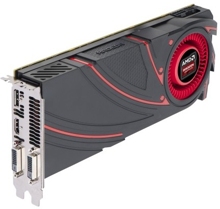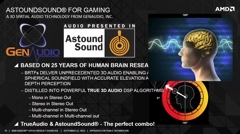
AMD ha annunciato ufficialmente la sua nuova gamma di video card, dedicate al mercato consumer, che attualmente include i prodotti Radeon R9 290X, R9 290, R9 280X e R9 270X, che compongono la linea R9 Series, e R7 260X e R7 250, inclusi invece nella linea R7 Series.
Come si intuisce dalla denominazione commerciale delle nuove Radeon, AMD ha rinnovato la nomenclatura utilizzata per catalogare le SKU, che naturalmente introducono anche e soprattutto innovazioni dal punto di vista tecnologico.
Come esemplificato, ai massimi livelli, dalla soluzione flag-ship Radeon R9 290X, la cui gpu (nome in codice: "Hawaii") è basata sull'architettura Graphics CoreNext (GCN) di seconda generazione, che è in grado di vantare un frame buffer da 4GB e il supporto di DirectX 11.2.
Tutti i prodotti delle linee R9 e R7 sono stati progettati, sottolinea AMD, per promuovere e supportare la nuova era del gaming in cui alle gpu e alle schede grafiche più in generale viene richiesto di alimentare display UltraHD (3840 x 2160).
Mentre le performance video delle nuove soluzioni nell'ambito multi-display, o multi-monitor, sono garantite dalla consolidata ed efficace tecnologia Eyefinity, con i processori grafici GCN 2 AMD punta a migliorare anche l'esperienza di gioco dei gamer dal punto di vista della resa dell'audio.
Più in dettaglio AMD ha introdotto la tecnologia TrueAudio che mira ad abbinare a sequenze di frame video di grande realismo in UltraHD dei suoni realistici, mediante, afferma il chip maker, "la simulazione della percezione, da parte del cervello umano, dei suoi del mondo reale".
Con TrueAudio la gpu non sostituisce l'hardware dedicato all'audio presente nel computer, ma lavora insieme a esso per riprodurre i suoi tipici della vita reale. "THIEF" di Square Enix e "Lichdom" di Xaviant Games sono due tra i primi game che supportano TrueAudio.
AMD non ha ufficializzato il periodo di lancio delle nuove gpu delle linee R9 e R7, specificando, comunque, che esse saranno acquistabili "nel prossimo futuro".
AMD Radeon R9 290X

[Immagine ad alta risoluzione]

[Immagine ad alta risoluzione]

AMD (NYSE: AMD) today unveiled the AMD Radeon R9 290X, R9 290, R9 280X, R9 270X, R7 260X and R7 250 graphics cards, AMD’s first GPUs in a new era of gaming defined by UltraHD displays, renewed vigor in game engine development, and a new generation of gamers that expect a more immersive entertainment experience. AMD also introduced the world to Mantle and AMD TrueAudio technology, the latest innovations that redefine the GPU by enabling both gamers and game developers with unprecedented audio and performance enhancements for compatible games1,2.
"The AMD Radeon R9 and R7 Series graphics cards are new GPUs for a new era in gaming," said Matt Skynner, corporate vice president and general manager, Graphics Business Unit, AMD. "This era is shaped by ultra-resolution gaming and an exciting new generation of highly-anticipated games like 'Battlefield 4'. But it’s also an era shaped in a very powerful way by our own Unified Gaming Strategy; we’ve teamed up with the world’s top game developers to establish a comprehensive portfolio of games that you can maximize to their full potential only with AMD Radeon graphics."
Mantle and Graphics Core Next: Simplifying Cross-Platform Game Development
The award-winning Graphics Core Next (GCN) architecture in the AMD Radeon R9 and R7 Series graphics cards continues to serve as a driving force behind the Unified Gaming Strategy, AMD’s approach to providing a consistent gaming experience on the PC, in the living room or over the cloud — all powered by AMD Radeon graphics found in AMD graphics cards and accelerated processing units (APUs). The four pillars of the Unified Gaming Strategy — console, cloud, content and client — come together with the introduction of Mantle.
With Mantle, games like DICE’s "Battlefield 4" will be empowered with the ability to speak the native language of the Graphics Core Next architecture, presenting a deeper level of hardware optimization no other graphics card manufacturer can match. Mantle also assists game developers in bringing games to life on multiple platforms by leveraging the commonalities between GCN-powered PCs and consoles for a simple game development process.
With the introduction of Mantle, AMD solidifies its position as the leading provider of fast and efficient game development platforms. Mantle will be detailed further at the AMD Developer Summit, APU13, taking place Nov. 11-13 in San Jose, Calif.
AMD TrueAudio Technology: World’s First Programmable Audio Pipeline
AMD TrueAudio technology marks a new frontier in realism for PC gamers. AMD TrueAudio technology empowers game developers with a programmable audio pipeline on the GPU, inviting them to put their unique artistic fingerprint on in-game audio in the same way that the programmable graphics pipeline brought unfettered artistic vision to PC graphics. Enabled games can feature more realistic environmental dynamics, a richer tapestry of sound effects, breathtaking directional audio and more.
AMD TrueAudio technology enhances audio realism by simulating the human brain’s perception of real-world sound, working in concert with the user’s existing audio hardware to recreate a lifelike experience in upcoming games like "THIEF" by Square Enix or "Lichdom" by Xaviant Games.
AMD Multi-Display Technology: Redesigned for Ultra-resolution Gaming
The arrival of the next-generation AMD Radeon graphics cards also marks a new chapter in AMD’s historic support for stunning display configurations. AMD Radeon R9 and R7 Series graphics cards are made for gaming on UltraHD (3840x2160) displays, including support for non-tiled 2160p60 displays with a future AMD Catalyst driver release. In addition, gamers more accustomed to AMD Eyefinity multi-display technology will be freed to use virtually any combination of display outputs when connecting matching monitors to the DVI or HDMI outputs on their system.
AMD Radeon R9 and R7 Series graphics cards will be available for purchase in the near future.
Source: AMD Press Release
Links



